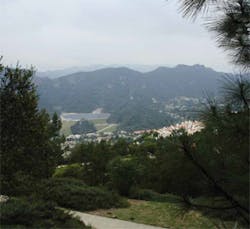Changes in the US Environmental Protection Agency’s water quality regulations have brought about renewed interest in geomembrane floating cover systems for the protection of critical water resources. Specifically influencing many districts in their water protection designs are revisions of the EPA’s Stage 2 Disinfectants and Disinfection By-Products Rule (S2DBPR) and Long Term 2 Enhanced Surface Water Treatment Rule (LT2ESWTR).
In answer to the first rule, the Los Angeles Department of Water and Power (LADWP) has opted to switch disinfectants from chlorine to chloramines. In answer to the second, it has opted to install a floating cover over the ~9.2-surface-acre Santa Ynez Reservoir.
The district chose a chlorosulfonated polyethylene (CSPE) geomembrane for its proven long-term performance in UV-intense exposed applications, and to satisfy some unique visual aesthetics the project team requested: camouflage.
Choosing A Cover
The Santa Ynez Reservoir, a domestic use facility, is not a new reservoir; but in adding a floating cover the operators were able to make some useful upgrades for both new water rule compliance and improved, forward-looking performance.
The cover for the facility was actually planned to be installed around 2006, but the project approval process (started in 2002) was delayed while waiting for confirmation of the EPA’s updated rules, which were not published until 2006.
The new, full project approval process then took another few years. After draining the 117 million-gallon reservoir between October 2009 and May 2010, the old inlet/outlet tower and pipeline was demolished and the asphalt liner, which had served the reservoir well, was repaved. New pipelines and appurtenances were then installed and the facility filled.
Then, in October 2010 another drain period was set forth to enable the last phase of reconstruction. This included the installation of the floating cover (work which began in January 2011).
A 45-mil, three-ply CSPE geomembrane from Burke Industries was specified. Constructed of two CSPE enhanced rubber layers and one layer of scrim reinforcement, these CSPE geomembranes are designed for long-term exposure to and durability against inclement weather and UV.
These CSPE geomembranes are designed for long-term exposure to and durability against inclement weather and UV.
The thickness of the Santa Ynez cover is perhaps not as common as one might find on newer reservoirs. Increasingly, 60-mil membranes are being specified for reservoir floating covers, especially since larger reservoirs are being constructed. For example, California’s new Upper Chiquita Reservoir, which has been constructed to an impressive 120 ft. depth, has been lined on its slopes and at the base with 60-mil polypropylene geomembrane while a 900,000+ sq. ft., 60 mil CSPE geomembrane has been installed as a floating cover. Santa Ynez, however, is older and shallower. A thinner floating cover was possible without sacrificing any service life or durability.
Roughly 650,000 sq. ft. of membrane was installed by Layfield Environmental Systems Inc. Burke shipped the 5-ft.-wide, 750-ft.-long rolls of black and green CSPE geomembrane to Layfield’s fabrication facility near San Diego, where panel welding experts were able to join the individual panels into 35-ft.-wide rolls.
Prefabrication-a characteristic that only flexible geomembranes offer enables some nice cost savings in that panels can be joined more quickly in the controlled environment of a fabrication facility than they can be on site where weather, site topography, and fluctuating temperatures may impact the speed of welding.
In addition to the CSPE cover itself, a chafer strip of the same membrane material was installed around the perimeter and extends about 2/3 of the way down the slope. This portion of the installation is not designed for containment along the slope but to prevent chafing of the slopes from the cover.
But what may be the real signature of this cover for the district’s water management strategy is the way it, and much of the site, has been customized in color to make the reservoir blend into its natural setting.
The floating cover has actually been “camouflaged.”
Visual Aesthetics
Everything about the Santa Ynez installation has been adapted visually to its immediate environment. This has included the rockwork, slope replantings, the color of the service road and debris retention basin (darker to blend into with the reservoir cover), “texturizing” the dam faces with naturalized drifts of native grasses, etc.
These measures are motivated by the high-dollar Pacific Palisades real estate in the immediate area.
The floating cover has been constructed of CSPE geomembrane panels that have been produced with a one-of-a-kind mix of black and green coloring in each panel. The color mix creates a largescale camouflage that helps the entire reservoir mimic the changing shades of the hills and vegetation. While this camouflage was a design first for the project partners, it was not a request that altered project costs.
Built to Last
CSPE geomembranes, which are also generically known as CSM, have been used as liners and covers for environmental protection applications in aggressive situations, such as for mine tailings ponds, and in potable water storage and protection for decades. Many in the engineering field refer to them by the brand name of the Du Pont elastomer formerly used in much of the CSPE membrane production (Hypalon®). While the Hypalon® brand is no longer produced, CSPE/CSM continues to be produced for a vast range of products. For geomembranes, this is especially welcomed. With 20, 25, and 30-year-old installations still functioning well and returning strong performance and polymer data, interest in CSPE is growing.
SPE geomembranes from the 1980s have actually outperformed many of the membrane formulations that were specified as alternatives to them in the mid-to- late 1990s and early 2000s. That is bringing many design engineers back to CSPE for relevant exposed geomembrane applications.
More floating cover systems can be expected to be designed into new and retrofitted reservoirs shortly. Water resource regulation changes for conservation and security will support and motivate many of these designs. CSPE geomembranes will be a steady part of those discussions.


